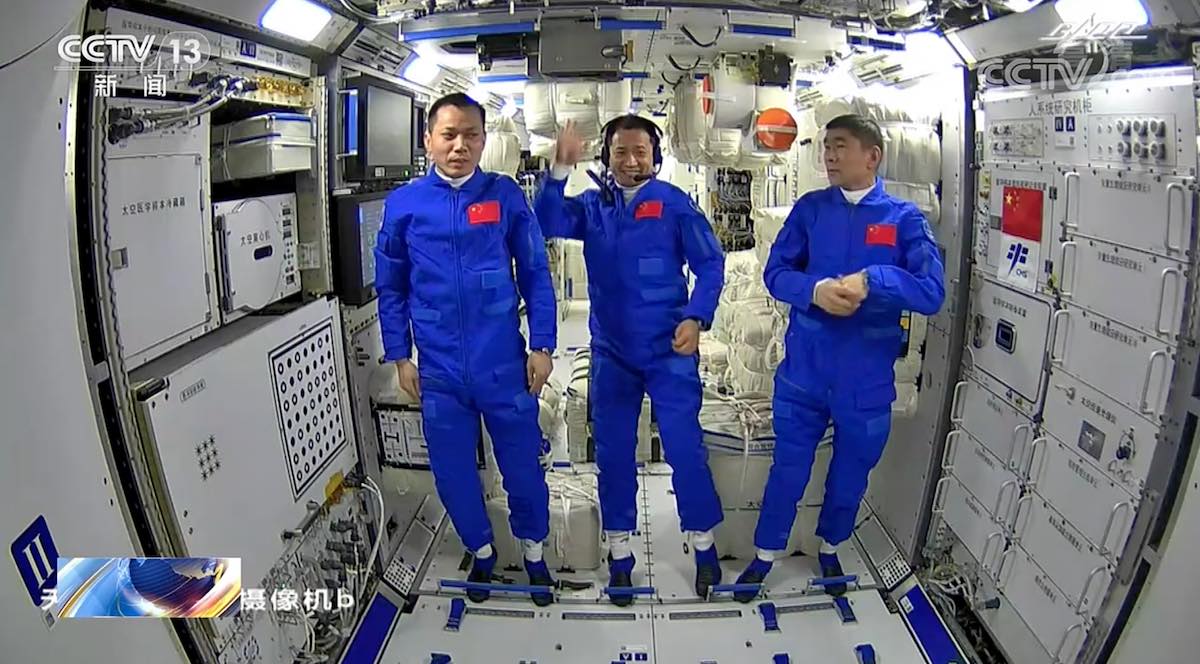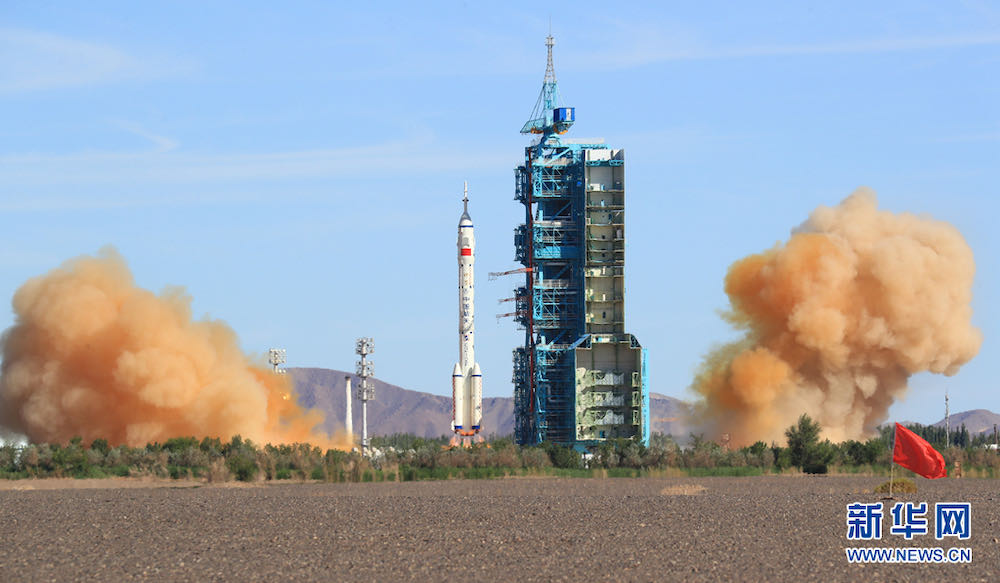
Three Chinese astronauts floated into the country’s new Tiangong space station Thursday, becoming the first people to board China’s outpost in orbit after a successful launch from a military base in the Gobi Desert to start a three-month mission.
Commander Nie Haisheng led the three-man crew into the space station’s Tianhe core module at 6:48 a.m. EDT (1048 GMT). Astronauts Liu Boming and Tang Hongbo followed Nie into Tianhe module through hatches leading from their Shenzhou 12 spaceship as the complex soared some 235 miles (380 kilometers) above Earth.
After taking a few minutes to get situated, the astronauts announced they had safely arrived at the partially-assembled Tiangong station and gave a military salute to officials watching from the ground. Chinese state television broadcast the event on a tape delay.
The choreographed arrival ceremony capped a long day for the three astronauts, who launched inside their Shenzhou 12 spacecraft on top of a Long March 2F rocket at 9:22:27 p.m. EDT Wednesday (0122:27 GMT Thursday).
Several hours before takeoff, Nie and his crewmates put on their pressure suits at the Jiuquan space base and rode a bus a few miles to the launch pad. After reaching the top of the launch pad tower, the astronauts climbed inside the Shenzhou 12 spacecraft on top of the 191-foot-tall (58-meter) Long March 2F rocket.
The launcher’s four core engines and four strap-on boosters flashed to life to propel the astronauts off the pad at Jiuquan, a military-run spaceport situated in the Inner Mongolia region of northwestern China.
Burning a toxic but stable combination of hydrazine and nitrogen tetroxide propellants, the rocket headed east atop 1.4 million pounds of thrust on a trajectory to line up with the Tianhe core module’s orbit.
Two-and-a-half minutes after liftoff, the four boosters and the Long March 2F’s core stage shut down and fell back to Earth in a remote area downrange from Jiuquan, leaving the liquid-fueled second stage to finish the job of placing the Shenzhou 12 spacecraft into orbit.
The rocket also jettisoned its launch escape tower and the aerodynamic shroud that covered the Shenzhou 12 spacecraft during the initial climb through the atmosphere.
About eight minutes into the mission, the second stage switched off its main engine. The Shenzhou 12 spacecraft separated from the rocket moments later, unfurled its power-generating solar panels, and kicked off an automated rendezvous to catch up with the Tiangong station.

China’s human spaceflight agency said the Shenzhou 12 capsule completed an automated docking at the forward port of the Tianhe core module at 3:54 a.m. EDT (0754 GMT), about six-and-a-half hours after launch.
The rapid rendezvous profile was a first for China’s space program.
While Chinese state television provided live coverage of the Shenzhou 12 mission’s launch, the docking occurred without any public broadcast. CCTV, China’s state-run TV network, replayed the docking about a half-hour after it happened.
After equalizing pressure on each side of the passageway between Shenzhou 12 and the Tianhe core module, the astronauts opened hatches and entered the Tiangong station.
Nie floated inside the complex first, followed by Liu and Tang.
The three astronauts will spend the next three months testing systems on-board the station, three times longer than any previous Chinese human spaceflight mission.
In total, China has now launched 12 astronauts into orbit on seven crewed Shenzhou missions since 2003.
NASA Administrator Bill Nelson congratulated China on the milestone mission.
“Congratulations to China on the successful launch of crew to their space station!” Nelson said in a statement. “I look forward to the scientific discoveries to come.”
One major task for the Shenzhou 12 astronauts will be to check the performance of Tiangong’s regenerative life support system, which produces breathing oxygen through electrolysis and recycles urine to make drinking water.
“This way, we have closed-loop resource to draw upon which can greatly reduce dependence on ground supplies, and of course increase the economic efficiency of the space station,” said Zhou Jianping, chief designed for China’s human spaceflight program.
Nie, a 56-year-old veteran of two previous Shenzhou missions in 2005 and 2013, leads the three-man crew. Nie logged more than 19 days in orbit on his first two spaceflights.
Speaking to Chinese media before the launch, Nie said the Shenzhou 12 mission’s objectives of activating and outfitting the Tiangong station will make for challenging work.
“We will work together to conquer all of those difficulties, and I am convinced that with the best wishes of my counterparts in China, and the solid preparation, and (our) training, we are capable of accomplishing this task,” Nie said.
“This space station is quite big in size, so this flight mission lasts longer,” he said. “We are taking a lot of things for entertainment … We will certainly show you all of those items we bring.”
The other two Shenzhou 12 crew members are Liu Boming and Tang Hongbo.
Liu, 54, participated in the first spacewalk for China’s space program on the Shenzhou 7 mission in 2008. Tang is 45 years old and will make his trip into space on Shenzhou 12.
Besides their tasks to configure the inside of the Tianhe core module for long-term operations, the Shenzhou 12 astronauts will perform two spacewalks, operate the lab’s robotic arm, and conduct science experiments, according to Ji Qiming, assistant to the director of the China Manned Space Agency.
“For this mission, we are going to stay for a longer duration in outer space, and we will conduct multiple extravehicular activities, so this is very challenging,” Liu said before the launch. “To that end, we have engaged in a lot of systematic training and practices.”
China’s human spacefight agency reports the Shenzhou 12 crew spacecraft docked with the Chinese space station’s Tianhe core module at 3:54am EDT (0754 GMT).https://t.co/0kSsL30i1W pic.twitter.com/KiEohBfbqr
— Spaceflight Now (@SpaceflightNow) June 17, 2021
The first element of the Tiangong space station, the Tianhe core module, launched April 28 aboard a heavy-lift Long March 5B rocket, China’s most powerful launch vehicle. An unpiloted cargo ship, named Tianzhou 2, launched May 29 and docked with the aft port on the Tianhe module eight hours later, delivering fuel, food and spacesuits for the Shenzhou 12 astronauts.
With the docking of Shenzhou 12 to Tianhe’s forward port Thursday, the entire station stretches nearly 120 feet (about 36 meters) long.
The Tianhe core module includes astronaut living quarters, medical equipment, a command and control element, and an airlock and exterior handrails for spacewalks. There are three sleeping berths — one for each astronaut — and one toilet on the Tianhe core module, Chinese officials said.
The core module of the Chinese space station also has a treadmill and a stationary bicycle for astronauts to get some exercise.
Nie and his crewmates will unpack the Tianzhou 2 supply ship and begin assembling the spacesuits. Chinese engineers upgraded the extravehicular units after the country’s first spacewalk in 2008, and the suits are now capable of accommodating astronauts for spacewalks lasting six-to-seven hours, according to Ji.
No matter how difficult the mission is, I have every confidence that with very professional ground support and with the coordination and cooperation from my very handsome two colleagues, (we will) meet all the challenges,” Liu said.
The Shenzhou 12 astronauts are scheduled to return to Earth in September for a parachute-assisted landing in China’s Inner Mongolia province. The landing will target a new recovery zone near the Jiuquan spaceport.
Around the same time, China will launch Tianzhou 3, the station’s next cargo resupply ship.
Tiangong means heavenly palace in Chinese, while Shenzhou is translated as divine vessel. Tianhe means heavenly harmony, and Tianzhou means heavenly vessel.
China’s next crewed spaceflight, Shenzhou 13, is scheduled to launch in October, carrying three astronauts for a six-month mission in orbit, according to the China Manned Space Agency.
Next year, China plans six more launches to support the space station program. Two Long March 5B rockets will boost the Wentian and Mengtian lab elements to dock with the Tianhe module, completing assembly of the three-segment, T-shaped space station.
There are also two more cargo spacecraft and two more Shenzhou crew capsules scheduled to launch to the space station in 2022.
When completed, the Chinese space station outpost will have a mass around 66 metric tons, about one-sixth that of the International Space Station, and closer in size to Russia’s retired Mir station. With cargo and crew vehicles temporarily docked, the Chinese station’s mass could reach nearly 100 metric tons, officials said.
China launched two Tiangong prototype space labs in 2011 and 2016 to test out technologies for the permanently-occupied space station. The Tiangong 1 space lab hosted two Shenzhou crews in 2012 and 2013. China’s most recent human spaceflight mission — Shenzhou 11 — docked with the Tiangong 2 module in 2016.
“After 10 years of research and development, we have now come to the phase of on-orbit assembly and construction of the space station,” Ji said in a pre-launch press conference.
He called the construction and operation of the Tiangong station “an important symbol (for) our country’s economic, technological and comprehensive strength.”
The space station will host technology demonstration experiments, biomedical research payloads, and astronomical observations, he said.
China plans to eventually permit astronauts from potential international partners to visit the Tiangong space station, Ji said.
“This will be my first time (in space),” Tang said. “Of course there will be pressure. I believe there are a lot of unknowns and uncertainties in outer space, but I have confidence that pressure can be transformed into motivation. With confidence we’ll definitely succeed with this mission.
“I have gone through years of training,” Tang said. “I have a lot of confidence in my team, as well as in myself. I am flying to outer space on behalf of my motherland. We will definitely work closely together and build our home in outer space.”
Email the author.
Follow Stephen Clark on Twitter: @StephenClark1.
